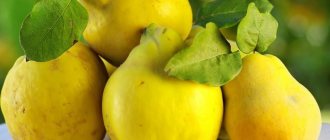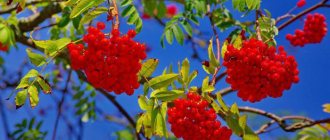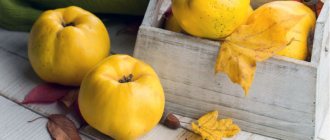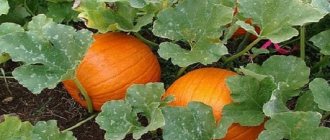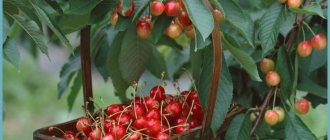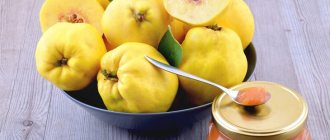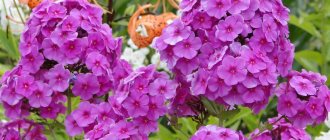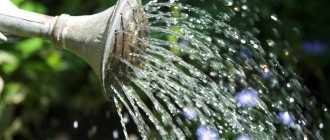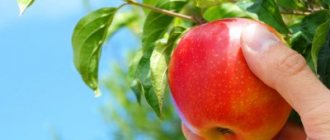For many decades, quince has been exciting humanity: Which fruit did Adam bite off: an apple or a quince? Legends and myths arose about the strange fruit; it was given a special place at weddings and other important life events. The quince fruit was considered a symbol of love and fertility. Quince is one of the most mysterious gifts of Mother Nature, which impresses with its aroma. Today, quince is still popular: it is used as food and in the creation of medicinal and cosmetic products. It is used as a hedge and as a tapeworm plant.
Features of quince
The quince fruit ripens on a small plant. Quince is a small tree with leathery leaves and surprisingly exquisite flowers that emit a refined aroma. Quince ripens towards the end of summer and mid-autumn: from late July to mid-October. Fruits are usually eaten in cooked form, since raw they are hard and have astringent properties. Quince impresses with its delicate aroma, light and unobtrusive. The shape of the fruit is a cross between a round apple and a pear. The shade of quince depends on the variety: the fruit can be green-yellowish, lemon and even golden. The skin is smooth, fleecy. The inside of a quince is the same as that of an apple or pear, but with a large number of small seeds. Depending on the variety, the fruits may also have different weights. There are specimens weighing more than 2 kilograms, so the wild quince can only please with small false apples up to 100 g. The plant propagates in different ways: seeds, cuttings and grafting, root shoots. The plant prefers heavy loamy soils, although on sandy loam soils fruiting begins much earlier.
Planting and caring for Japanese quince in the Moscow region
Japanese quince can be grown in the Moscow region, but for this it needs to be provided with proper care. Basic requirements for planting: fertile soil, timely watering, fertilization and careful mulching for the winter.
Landing dates
In the climatic conditions of the Moscow region, it is better to plan the procedure for late spring. It is better to plant in the last ten days of April or early May. At this time, the soil should have time to warm up to at least 10–12 degrees. This can be determined by burying the thermometer to a depth of 15 cm and holding it for 15–20 minutes.
If the spring turned out to be cold, it is better to postpone planting quince in the Moscow region 1-2 weeks later
An autumn procedure is possible, but undesirable. If the deadline is missed in the spring, the seedlings need to be planted in the first half of September, i.e. 1.5–2 months before the first frost. In this case, you need to take special care of the winter shelter.
To ensure proper care of Japanese quince in the Moscow region, seedlings should be planted on a fine day, early in the morning or late in the evening.
Important! The leaves of a fragile plant do not tolerate strong sunlight.
Requirements for place and soil
Japanese quince also ripens in the Moscow region, but in order for the bush to feel comfortable, it is important to choose the right place for planting it. It should be:
- completely open (even weak shading is not allowed);
- protected from drafts and strong winds (especially from the north);
- not waterlogged (lowlands where moisture periodically accumulates should be excluded).
Japanese quince prefers light, fertile loamy soils. It is best if the reaction is slightly acidic (pH = 6.0–6.5). Therefore, the soil for planting should be prepared in advance. To do this, the area is cleared and dug up in the fall. A bucket of compost or humus is added to the soil (per 2 m2), as well as 1 kg of sawdust or sand for the same area (if the soil is heavy, clayey). Sometimes the soil in the Moscow region can be alkaline (pH more than 7.0). Then before planting you need to water it with 9% vinegar. Working solution for 1 m2 area – 100 ml per 10 l.
How to plant correctly
It is better to buy Japanese quince seedlings for planting in the Moscow region from nurseries or from trusted suppliers. Their age should be 1 - maximum 2 years. The root system is closed (in planting containers).
Prepare for planting several weeks in advance:
- Dig holes 60 cm deep and 60 cm in diameter at a distance of 1.5 m from each other.
- Small stones are placed at the bottom. This must be done when groundwater comes too close to the surface. The drainage layer should be thick enough - up to 15 cm. Then further maintenance will not cause difficulties.
- Pour a mixture of turf soil with compost, black peat and sand (2:1:1:1) and let it sit for 2-3 weeks.
- Then the Japanese quince seedlings are placed exactly in the center and the soil is compacted slightly so that the root collar goes to a depth of 5–7 cm.
- Make a small depression around the trunk.
- Mulch with bark, sawdust, pine needles or other materials.
When planting Japanese quince in the fall in the Moscow region, it is important to thoroughly mulch the roots.
Attention! To ensure that the seedlings survive the winter well, lay a high layer of dry foliage, peat, and sawdust.
How to care
Along with planting, it is important to provide proper care for Japanese quince in the Moscow region. There are several rules that must be followed:
- Young seedlings need increased weekly watering. At the same time, the soil must have time to dry out - stagnation of moisture is unacceptable.
- Grown bushes need watering only during dry periods. They are given 3-4 buckets of water every week. If it rains periodically, additional moisture is not needed.
- Another important rule for caring for Japanese quince in the Moscow region is feeding. If fertilizers have already been applied on the eve of planting (or during it), then new fertilizers are given only from the next season. In April, you need to apply 150 g of potassium nitrate and 300 g of superphosphate to each seedling. In June, ammonium nitrate (20 g) is used, and in September they are fed with mullein (30 g per 3 liters per plant).
- The tree trunk circle is mulched even in summer. This gets rid of weeds and protects the soil from rapid drying out, and the roots of Japanese quince from recurrent frosts. Although you still need to loosen the soil and periodically remove the grass.
- An essential care requirement is regular pruning of Japanese quince. In the spring you need to remove frozen, diseased and weak branches (at the very beginning of April). And in the fall (mid-October) they do a shaping and rejuvenating haircut. To do this, you need to trim branches that extend beyond the general contour, leaving at least a third of their length. All cut areas are treated with crushed charcoal or garden pitch.
When and how to collect Japanese quince in the Moscow region
In the climatic conditions of the Moscow region and other regions of the central zone, Japanese quince ripens quite late. This occurs in the fall: from the end of September and lasts until mid-October. The yield from one adult bush reaches 1–2 kg. If you organize proper planting and good care, you can achieve 2.5–3 kg per crop.
Japanese quince in the Moscow region does not have time to ripen completely and remains green
The unripe harvest must be harvested before frost, otherwise it will die and be lost. The pulp may become watery and lose flavor. Therefore, the fruits are removed and placed in one layer on the floor in the room. They can be stored for quite a long time in such conditions. Gradually the fruits will acquire a normal yellowish color.
It is better to collect Japanese quince in dry, clear weather so that it does not get wet. The fruits are picked by hand, but not thrown, but carefully placed in a bucket or other container.
Ripe quince is stored at a temperature of 2–3 degrees Celsius (on the balcony, in the cellar, basement). The humidity in the room should not be very high - up to 70%. Under such conditions, Japanese quince can be stored without additional care for 4–5 months.
Attention! During harvesting, do not rub your nose or eyes, as small fluffs can irritate the mucous membrane. After this, it is advisable to gargle with a soda solution (a teaspoon per glass of warm water).
Preparing for winter
One of the main rules for planting and caring for quince in the Moscow region is timely preparation for winter, which is especially important for young seedlings (the first 2–3 years). Warming measures begin three weeks before the first frost, i.e. around mid-October.
To protect the roots, you need to pour a high layer of mulch (at least 20 cm) into the tree trunk circle. It is acceptable to use spruce branches, bark, fallen leaves (but only from other trees), and sawdust. It is also recommended to install a shield from wind and snow next to the plant.
Growing a tree
The many methods of propagation testify to the unpretentiousness of the culture, its high survival rate and excellent germination in different climatic latitudes. Quince is a relative of the usual apple or pear trees. The method of its cultivation is not much different from these crops. Quince:
- prefers warm and sunny places;
- responds gratefully to abundant watering;
- resistant to prolonged drought;
- undemanding to the composition and structure of the soil.
Quince is a beautiful tree with winding branches, the height of which reaches up to 7 m. The lifespan of the plant exceeds 30 years. It is recommended to plant a young tree in mid-autumn or mid-spring. Preference should be given to specimens with a well-developed root system. Strong plants with a formed crown are planted in pits with a diameter of up to 1 m and a depth of up to 60 cm. To increase nutrients and faster establishment of the crop, the bottom of the pit should be covered with humus or compost, 10 cm thick. Young crops are planted in a row of several crops for more high-quality pollination, respectively, higher fruiting. Tree care is minimal: timely shortening of dry and damaged branches and very elongated shoots. Quince has been grown in Europe for many centuries, but for our summer residents it is a relatively new plant. Many people grow quince not as a cultivated plant, but as an ornamental plant. Indeed, in regions with a harsh climate, its fruits do not quite have time to ripen. Wild specimens that are more resistant to diseases and weather conditions are used as ornamental plants. Wild quince is ideal for pruning and is often used to create hedges. Gardener breeders grow quince as a rootstock for pears. The culture grafted onto it is more resistant to adverse weather conditions, tolerates drought or high humidity well, and has a compact size. Today, breeders are working to create a variety that would have time to ripen before the onset of cold weather, have more tasty fruit, and be resistant to diseases.
Quince planting rules
In order for quince to please you with high productivity, you should take care of its proper planting, cultivation and care. We recommend that you plant quince in the central part of your garden plot, which is reliably protected from the wind.
The fruit crop takes root well in soils where groundwater approaches the surface one meter.
When planting, consider the following factors:
- prepare the seat in early March or September, it should be 40 cm deep and 80 cm wide;
- pour some clay into the bottom of the hole;
- pour fertilizer into the hole a few days before planting.
For fertilizer, use a composition of 50 g of ash, 150 g of superphosphates, a small amount of lime and soil.
You must also adhere to the following rules:
- choose an area for planting that is well lit by the sun, and there are other fruit trees nearby;
- Cultivate the fruit crop in a climate in which the average daily temperature per year is no more than 9 degrees;
- Water the tree 4-5 times per season.
Watering young cuttings is carried out on days 2–3, adult shrubs - before flowering. The second watering should be carried out during the formation of flowers, the third - during the formation of ovaries. Carry out the fourth watering when the shoots grow, the fifth during the growth and formation of fruits.
Top dressing
The first feeding from a mineral-organic composition will be enough for a year. Organic matter should be applied once every 2 years, mineral fertilizing should be done at the beginning of autumn, spring and summer:
- fertilizing with nitrogen is poured near the ground in early spring;
- as soon as the quince fades, the soil should be watered with a mixture of 0.2 kg of potassium-phosphorus fertilizers diluted in 10 liters of water;
- Apply fertilizers based on phosphorus and potassium in early August.
Carry out mulching with compost and peat in spring or autumn, spreading the composition in a layer of up to 5 cm.
Troubles that can befall a tree
The main reason that many summer residents refuse to plant amazing plants on their site is the instability of quince to diseases. In addition, quince is a favorite delicacy among rodents, birds and pests of pome crops.
To avoid many troubles associated with diseases and pests, quince should be planted at some distance from apple trees, hawthorn and rowan.
The most common disease of the crop is fruit rot - moliniasis of pome fruit. The disease can only be eliminated with an integrated approach. To fight the disease you need:
- trim and burn affected branches;
- disinfect wounds with mercuric chloride.
Eliminating a disease is much more difficult than preventing it. For preventive purposes, it is recommended to spray the tree with foundationazole and dipterex during the period from the swelling of the buds to the appearance of the first flowers. Treatment with these products is carried out in accordance with the manufacturer's recommendations. Subcutaneous fruit spot can also cause great harm to unripe fruits. The disease reduces the high quality of quince and makes the fruit unattractive. To prevent the disease, the plant should be fed with boric acid or zinc sulfate. Also, when choosing a variety for cultivation, preference should be given to the one that is most resistant to the disease. Quince is also affected by brown leaf spot, which is caused by certain fungi. During the flowering period of the plant, fungal spores fall on the flowers and subsequently lead to the fall of the ovaries. Prevention of the disease is simple: timely spraying with foundationazole. The most popular insects that love to eat quince include:
- apple false bark beetle. It can only be eliminated mechanically: insects are collected by hand in April and September, when inspecting tree trunks and branches;
- codling moth. To preserve the harvest, fruits that have reached a diameter of more than 2.5 cm are placed in paper bags for further growth and full ripening;
- leaf moths. These insects are immune to insecticides. They fight the pest mechanically by cutting off infected leaves. Iridescent beetles, the natural enemies of moths, are excellent helpers in fighting them.
Why doesn't Japanese quince bear fruit?
Japanese quince may not bear fruit for various reasons. In most cases, the gardener himself is to blame for choosing the wrong place for planting or making gross mistakes when caring for the plant. Chaenomeles cannot be called a capricious culture, but even it has minimum “requirements”.
Sometimes Japanese quince does not bloom at all. It is logical that in this case there is no need to harvest the crop in the fall. The most common reasons for this phenomenon:
- Planting in a shaded place. If Japanese quince does not have enough light, the tree grows and develops much more slowly than usual. The process of formation of flower buds is disrupted, and gradually budding stops completely. During the first few seasons, it is still possible to harvest from Chaenomeles, albeit a meager one; after that, it does not bear fruit at all.
- Unsuitable soil. Japanese quince prefers nutritious, but water- and breathable soil. Otherwise, the roots of the plant suffer, which negatively affects the entire process of its development. The root system cannot provide the tree with nutrients in the required amount, so it does not bear fruit.
- Excessively abundant watering. When overwatered, the root system almost inevitably rots. The tree may even die, not to mention the ability to collect fruit from it.
- Excess nitrogen-containing fertilizers. They stimulate Japanese quince to actively increase green mass. Such a tree will not bear fruit - it simply does not have enough nutrients for the harvest to ripen.
Japanese quince needs nitrogen in moderation and only at the beginning of the active growing season.
The tree really does not like vegetation in the tree trunk circle. This can also cause a lack of flowering and fruiting in Japanese quince. It needs to be weeded regularly; this is not a suitable place for planting lawn grass or ornamental ground cover plants.
Japanese quince begins to bear fruit a year or two later than it blooms. This is normal for a tree. However, if after this time the crop still does not ripen, the reasons may be as follows:
- Lack of pollinators. Most varieties of Japanese quince are self-sterile. To regularly collect fruits, you must first provide the tree with “neighbors” by planting 2-3 more Chaenomeles specimens nearby. Only in this case, after flowering, fruits will begin to set en masse.
- Freezing of fruit ovaries. In regions with a climate that is not very suitable for gardening, chaenomeles may be subject to return frosts after flowering. They destroy the ovaries; this season, Japanese quince cannot be expected to ripen.
- Incorrect and/or untimely pruning. Most of the buds are concentrated on branches that are 3-4 years old. Then you have to collect fruit from them. Also, Japanese quince stops blooming and bearing fruit if sanitary pruning is neglected (unnecessary “ballast” takes too much strength from the tree). It is also strongly not recommended to get rid of healthy shoots during the summer, when the plant has already bloomed and is forming fruit ovaries.
- Pathogenic microflora. Japanese quince has fairly good immunity. However, if a gardener neglects to care for chaenomeles, he may well get sick. Some fungi (for example, moniliosis) affect fruits - they rot, dry out, and fall from the tree without having time to ripen.
Important! There are hybrid decorative flowering varieties of Japanese quince that do not bear fruit at all. If you plan to harvest later, you need to carefully study the varietal characteristics of the tree before purchasing.
Some varieties of chaenomeles are intended solely for decoration of the site
Composition of fruits and their beneficial properties
The composition of quince fruits directly depends on the variety of the plant and the conditions of its maintenance, the climatic zone of growth. But the most useful property, regardless of all the features, is the high value of the composition. Ripe fruits contain significant amounts of fructose and other sucrose, tannins, various acids, and essential oil. The skin of the fruit is also full of useful components, the main of which are ethyl esters.
The ripe fruit has medicinal properties contained not only in fresh fruits, but also in seeds. Quince fruits are very rich in iron. For treatment, quinces are used fresh, and juices are prepared from them. This is an effective remedy for anemia and has a choleretic effect on the human body. Quince juice has been used for many decades to relieve pain from hemorrhoids. Quince seeds are rich in tannic and mucilaginous components. In alternative medicine they are used to prepare medicinal light decoctions. A decoction of quince seeds is considered an effective remedy against diseases of the respiratory system. It is taken for severe cough. It is also worth noting that a decoction of quince seeds, as well as the fruit and tree itself, are widely used in cosmetology. For example, lotions made from a decoction of seeds are used to soften the skin, and a decoction of leaves is used for the beginning manifestations of gray hair. Quince perfectly retains its properties even when cooked. Due to their strong astringency, the fruits are not used fresh, but even when cooked they are rich in:
- acids: malic, citric, tartronic;
- vitamins: ascorbic acid, beta-carotene, group B;
- microelements: potassium, calcium, magnesium, phosphorus, sodium.
Quince, when naturally ripe, has antioxidant and antiviral properties. That is why it is used for viral infections and colds. It significantly reduces the negative impact of diseases on the body. The juice and pulp of the fruit are used to lower cholesterol levels, for vomiting and diseases of the gastrointestinal tract. It is used in various diets, including for weight loss. Quince is an ideal anti-stress remedy. It has a beneficial effect on a person and tones the entire body. To boost the immune system, take quince juice, which simply works wonders in the fight against ac class=”aligncenter” width=”700″ height=”400″[/img]
The best self-fertile varieties of Japanese quince for the Moscow region
When growing ordinary quince in the Moscow region, it is important to choose the right variety. It must be not only winter-hardy, but also self-fertile. Thanks to this, there will be no need to plant other varieties or attract pollinators - the fruits will set on their own.
Quince is used for fruit production and also as an ornamental crop.
Zubutlinskaya
Zabutlinskaya (Zubutlinskaya) is a medium-sized bush. With proper planting and care in the Moscow region, it produces fairly large fruits. They have good transportability and keeping quality, so they can be transported over long distances. This quince variety is winter-hardy and tolerates strong gusts of wind.
Zabutlinskaya quince is immune to common diseases
Pink Lady
Pink Lady - another winter-hardy variety that requires simple care
The bushes are low, reaching only 120 cm. At the same time, the crown is beautiful, lush, and the flowers are pale pink. Thanks to this, the variety got its name Pink Lady.
Sargentii
Variety Sargentii (Sargentii) is characterized by long and abundant flowering
The culture produces fairly high and stable yields. The crown is spherical, the foliage is dark green, the flowers are orange. The variety is undemanding in terms of care - it can be grown in the Moscow region.
Nicloline
Variety Nicloline is a medium-sized bush up to 120 cm high. Its crown is spreading, reaching 1.5 m in width.
The flowers of the Nikolin variety are bright red in color.
Maintenance is easy. The culture requires minimal shelter for the winter. Nikolin's winter hardiness indicator is high.
Elly Mossel
Elly Mossel – decorative variety
The bush grows up to 70 cm in height. The inflorescences are bright red. Suitable for planting in flower beds with medium-sized flowers. Looks good in compositions, especially in alpine slides.
Geisha Girl
Geisha Girl (Geisha girl) is a medium-sized bush up to 150 cm high. It blooms in early May, the flowers are pink-cream. They are used not only for growing fruits, but also for decorating the garden.
The Geisha Girl variety is used in single plantings and compositions
The Geisha Girl variety is used in single plantings and compositions
The harmfulness of quince
Quince, as a medicinal plant, has a number of contraindications:
- the seeds have an astringent effect, which is why infusions from them are not used by people with ulcers and enterocolitis;
- do not use in the presence of constipation, pleurisy;
- The peel can irritate the larynx, so singers should use quince with caution.
Important! Quince seeds are strictly prohibited from being crushed or consumed in crushed form. During processing, a substance unsafe for humans is released - amygdalin.
Common varieties
Today, breeders have created a huge number of varieties, but the most popular are:
- Early oilseed, characterized by early ripening;
- Nutmeg, distinguished by a delicate aroma;
- Aurora, which is highly resistant to adverse climatic conditions;
- Anzherskaya, the fruits of which are used for processing and can be eaten fresh;
- Golden: yield is more than 40 kg per tree;
- Kaunchi-10, characterized by sweetish fruits that can be used fresh.
The meticulous work of breeders allows gardeners today to enjoy fresh fruits, prepare amazingly flavored dishes, compotes, and baked goods.
Features of laying ovaries
Quince bears fruit differently than apple or pear trees. A fruiting bud is formed in the axils of the leaves, which in the process of growth turns into a shoot up to 7 cm. The shoot ends with a bud on which a large flower opens. After pollination, a fruit is formed in place of the flower. Buds for fruiting are laid in the year that precedes the harvest period. Modification of the buds begins in late autumn, in October, and lasts until the onset of the first frost. In winter, when all processes slow down, this process is suspended and continues only with the arrival of the first sunny days. As a rule, one-year-old shoots bear fruit. At the end of spring, the apical fruiting bud and several lower ones bloom. To obtain a more abundant harvest, you can pinch the top bud.
When does quince bear fruit?
The quince harvest is one of the last to ripen. Fruits are harvested in the second ten days of October. And if autumn turns out to be warm and dry, you can postpone it even until early November.
Chaenomeles is practically the last thing that a gardener collects before “preserving” the site for the winter
When and in what year does quince begin to bear fruit after planting?
Japanese quince is a fast-growing crop. The tree, subject to proper care and the right choice of location, bears fruit within 3-4 seasons after the seedling is planted in the ground. A harvest of small (50-70 g), bright yellow “apples” is harvested from it.
Autumn is the time to harvest
Quince bears fruit in the autumn, from the beginning of September until the first frost. In order for the fruit to acquire an unsurpassed aroma and memorable taste, it is recommended to leave it on the mother plant for as long as possible. Quince with an early period of ripening is suitable for immediate use as food. Such fruits are stored worse than late-ripening crops. To acquire a natural taste, late-ripening quinces must sit for more than 20 days. Breeders have developed varieties of quince, the fruits of which are very tasty even when raw. But for this they must “rest.” After harvesting, after 1 month of storage, the quince acquires a yellow color, and the pubescence disappears. The structure of the pulp also changes. It becomes much more tender, the astringency goes away. During long-term storage, the beneficial properties of the fruit are significantly reduced, which, however, is normal for any type of crop. Quince fruits are stored until spring. To do this, they are sprinkled with sawdust and taken out to a dark, cool room. Some owners store the harvest by creating “braids” from willow branches and quince fruits. You can store quince together with apples. Storing in the same container with pears leads to rapid ripening of the fruit, which contributes to its accelerated process of destruction. Quince also keeps well on the lower shelves of the refrigerator. For such placement, each fruit must be wrapped in paper and folded in plastic. The most optimal temperature for storage is from 0 to +1 degrees. Quince can also be stored in rooms up to +8 degrees with humidity up to 80%, but ripening occurs much faster. The shelf life can be up to 120 days.
Signs of quince ripeness
If you want to get maximum benefits and enjoy the aromatic taste, choose only ripe fruits. You can tell if a quince is ripe by its appearance:
- Ripe fruits have a bright yellow uniform color.
- If you need a harvest for long-term storage, choose fruits that do not contain mechanical damage - dents, cracks and blackening. Fruits with smooth, smooth and hard skin are excellent for winter storage.
- Use soft fruits to prepare desserts and culinary dishes. They have a pronounced aroma and taste.
- Large Japanese quince fruits are more fragrant than small ones. The presence of green spots on the surface is a sign of unripe fruit.
- The longer the fruits are on the bush, the tastier and more aromatic they become. The main thing is not to overdo it and have time to harvest before the first frost.
Wrapping in paper is one of the reliable ways to store quince
Where are ripe fruits used?
Ripe quince is an excellent cosmetic product. Quince pulp is used as masks, which have antiseptic and drying properties. Such procedures deeply nourish the skin, saturating it with beneficial vitamins and microelements. To prepare masks, fresh pulp is used, mixed with butter, starch, egg yolk, and cereal flour. Quince masks:
- fresh pulp is applied in a small layer to the face for no more than 10 minutes. This is an excellent product for oily skin, which eliminates fatigue and helps fight acne in adolescence;
- Mix the fruit pulp with egg yolk and oatmeal until smooth. The mask is applied to cleansed face and décolleté for 10 minutes. The mask ideally refreshes combination and normal skin;
- Mix quince pulp with oatmeal and corn starch. The mask is applied to clean skin for 20 minutes and is suitable for all skin types.
Quince lotion is also ideal. It does not contain dyes or harmful substances, and has a very delicate aroma.
Cooking
How to use this fruit in cooking? Due to the high content of pectin, Chaenomeles fruits have a gelling property. Therefore, this product is especially in demand in cooking.
A wide variety of desserts, dishes and preparations for the winter are prepared from it (syrup, marmalade, candied fruits, jam, preserves). A slice of quince can be put into tea. It will be an excellent substitute for lemon.
So, we have already figured out whether the fruits of the Japanese quince are edible or not, and now let’s move on to the most interesting part - preparing mouth-watering and aromatic desserts. These are simple yet delicious recipes that you should include in your cookbook.
Recipe 1. Quince jam
Required ingredients:
- Japanese quince - 2 kg;
- sugar - 3 kg;
- water - 2 glasses.
Combine water and sugar in a metal bowl and bring to a boil. While the syrup is boiling, you can prepare the fruit. Rinse thoroughly, cut out unnecessary parts and remove the core and seeds.
Cut the pulp into cubes or slices, as you prefer, and pour boiling syrup over it. Bring to a boil and set aside for a couple of hours. Then put it on the fire again and boil.
You need to do this 3 times. This method of cooking will preserve the integrity of the pieces. Then the prepared jam will not only be tasty, but also beautiful to look at.
Place the hot product into clean jars and roll up.
Recipe 2. Candied fruits
Required Products:
- Japanese quince - 1 kg;
- sugar - 1.5 kg;
- water - 600 ml.
First you need to prepare quince jam. Wash the quince, cut in half, remove the seeds and remove the inside. Cut the pulp into slices. Place the slices in a saucepan, add water and sprinkle with sugar. Place over medium heat, bring to a boil, and simmer until tender.
After cooling, drain the syrup. Spread the fruit evenly on a baking sheet, sprinkle with sugar and place in the oven or microwave to dry. Transfer the dried candied fruits into a plastic bag and store in the refrigerator. For a piquant taste, they can be sprinkled with powdered sugar and cinnamon.
Marianna Pavley
Using quince in cooking
The taste of quince is similar to pear only when boiled. In its raw form, it is a tart and sour fruit. Quince is prepared in different ways. Before the cooking process, it is necessary to remove the hairiness, you can even remove the skin. The fruit is cut and the core removed. The skin can be boiled in sugar syrup and used in baking, compotes, creams, and jelly. The core is dried and used to prepare medicinal decoctions. The peeled fruit is cooked in sugar syrup. During heat treatment, it becomes soft and very tasty. In fact, quince is a beautiful and useful tree in the garden. She will delight you with beautiful early spring leaves, fragrant delicate flowers, interesting fruits ripening on the tree and delicious dishes. She deserves to have a place in every dacha. Moreover, such a tree does not require special care.
Article Rating
When to remove quince from the garden. Quince fruits: when to collect, how to store correctly
Quince fruits ripen very late. Therefore, the quince harvest is harvested almost at the latest: depending on the variety, from September to November. Gardeners have different attitudes towards this crop: some prefer to only process it, make jam, for example, while others love fresh fruits with a tart and unusual taste. No matter how anyone feels about quince, its beneficial properties have long been proven. However, the maximum “usefulness” accumulates in well-ripened fruits. Therefore, it is very important to know when to start harvesting. In this article you will find detailed information on when is the best time to harvest and how to store quince fruits.
Quince fruits: when to collect quince. Quince: photo of fruits
Quince fruits: when to collect quince. Quince: photo of fruits
Quince ripens best on a tree, so in case of warm autumn weather, you need to leave the fruits on it until the last: this way you will collect the most delicious fruits. But if the fruits turn bright yellow and begin to fall, it means the harvest is ripe and can be harvested. If the weather is not favorable and frosts come early, the quince can be harvested unripe. The main thing is to have time to remove the fruits from the tree before they freeze, as they will not only lose their taste, but also will not be able to be stored for a long time. Quince harvested ahead of schedule can ripen indoors, so it is possible to store unripe fruits.
Quince: how to use the fruits, how and where to store them
Quince: how to use the fruits, how and where to store them
Late varieties are best suited for storage because they usually do not ripen on the branches before frost. Even despite the green spots that indicate the unripeness of the fruit, quinces are removed from the tree, but are not eaten because of their sour and tart taste. Such fruits ripen indoors for 20-30 days. During this period, the quince fruits turn yellow and acquire a pleasant taste. Quince is well stored, so it can retain all its taste and beneficial properties for a long time. To do this, you need to place the fruits in boxes and sprinkle them with sawdust. It is advisable to place the boxes in the cellar, since quince are best stored in a cool, but not very humid place. If you wrap each fruit in paper, then a couple of dozen “packages” can be stored on the bottom shelf of the refrigerator. It is also possible to store quinces in a box along with apples. But with pears, this is not possible, since the fruits ripen faster.
